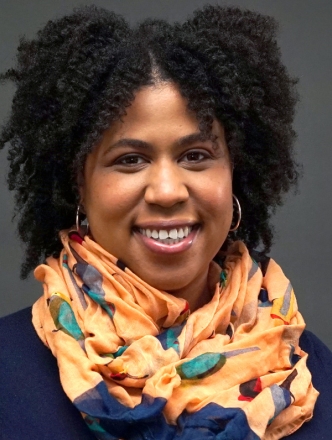
In spring of 2020, Dr. Stephanie Cook (Assistant Professor of Social and Behavioral Sciences and Biostatistics, NYU School of Global Public Health) received an IHDSC Seed Award for “Optimizing a Daily Mindfulness Intervention to Reduce Stress from Discrimination among Sexual and Gender Minorities of Color” with Drs. Erin Godfrey and Shabnam Javdani as co-investigators. This research focuses on uncovering mindfulness strategies that build awareness, purpose, connection, and positive reappraisal among emerging adult sexual and gender minorities (SGM) of color, a group that experiences a disproportionate burden of mental health disparities as compared to older SGM and non-SGM counterparts. On the Ground interviewed Dr. Cook in September of 2021 at a halfway point in her data collection to discuss why this research is important, what makes her research design innovative, and her hopes for where this research will lead. Dr. Cook’s remarks were edited for clarity and length.
Could you tell us about the inspiration or motivation for this research and how you hope it will contribute to dismantling disparities in health?
There's been a lot of work generally on mental health and suicidal ideation, for example, and SGM generally. But what a lot of work has failed to do is really understand the specifics for SGM who are also racial and ethnic minorities. I think the way in which we engage in and evaluate mental health when you're at the intersection of multiple potentially vulnerable positions needs to be considered, and we need more work in this area. There is some research from myself, other researchers here at NYU, and some people across the nation showing there are higher rates of stress from discrimination among SGM of color that causes poor mental health.
I was really motivated by this work when I put in this grant because we have a lot of research, and we need to do something about it. So, what can we do about it? At the time, I happened to be teaching a section on mindfulness in one of my classes. We know from the mindfulness world that there's so much research that points to how effective mindfulness interventions are. However, “mindfulness” means lots of different things. There are so many different mindfulness interventions and many different delivery modes such as in person or app-based. Then we have to decide if we are talking specifically about mindfulness meditation, so on and so forth.
This work is really about reducing stress from discrimination so that we can improve mental health and well-being among SGM of color, which is a population largely invisible. So, it's really about making the invisible visible.
The research aspect is trying to implement a rigorous process for understanding what components of a mindfulness-based intervention really work to reduce stress from discrimination and improve mental health and well-being among SGM of color. The most critically important part of this research is that we're trying to find a solution that meets the criteria of immediately scalable and cost-effective.
The preparation for this grant was a year in the making, because you have to find the right community partners who are on board with your vision and understand what you want to do and that will really want to partner with you as opposed to just being a consultant, which is also okay. However, for this vision, there is a need to create something that we can immediately take to the field that's immediately scalable. It was really important to work with partners such as Healthy Minds Innovations that were on board with this vision. They run the Healthy Minds app, which is mindfulness-based and backed by rigorous scientific research. Even though it’s a non-profit, it came out of the work at the University of Wisconsin-Madison, so all of the mindfulness training is scientifically backed. We worked with their engineer on the project to come up with the meditations in the app. It was truly a partnership, and we plan to put in a bigger grant together as partners. They’re wonderful people, and they’re invested in the vision.
You take an innovative approach to the research on this project. Can you tell us how you're approaching the research and why you chose to do it this way?
As I mentioned, it was important to craft an intervention that's immediately scalable. In the world of intervention design, we typically have a lot of interventions that are made up of a lot of different components, and then we do random clinical trials (RCTs) with this packaged intervention, but then we're not really sure what aspect of the intervention really worked if there's a lot of different components. When we have these packages of interventions, they are also usually very costly, which limits the sustainability of these interventions. They might work beautifully but, per individual, they cost $500, and a lot of community-based organizations can't spend $500 per person to implement an intervention.
We use the Multiphase Optimization Strategy (MOST) framework, an optimization framework spearheaded by Dr. Linda Collins. The difference between an optimization and an RCT is that we have specific outcome goals, and everything we do is towards these outcome goals. The goal or optimization criteria for this study is to create something cost-effective and immediately scalable. That means that when we go back and analyze the data at the end, we want to make sure that it meets the aforementioned goals. We might find that two different components of this intervention have high efficacy, but there's another two components of the intervention that work well together. They might have slightly lower efficacy, but they meet the goals and thus, based on that optimization criteria, we might go with those components. Taking this approach means that I'm able to meet those goals in terms of the design.
The design is super innovative. We have eight conditions as a factorial experiment, and we look at the effectiveness of different components of the mindfulness intervention on the outcome. Then we also look at the interactions between different components on the outcome. At the end, we'll be able to tell the effectiveness of the different intervention components.
Even though it's a factorial experiment, the innovation in the design and the method is really about how well we achieve our optimization criteria. I think that with this strategy, we will have a really great idea about what the intervention package should be at the end.
You set out to do this research on stress reduction prior to a lot of major stress-inducing global and national events including, but not limited to COVID-19, police violence and subsequent protests, elections, etc. How did all of these impact your research over the past year?
It has been quite challenging. We had Black Lives Matter protests and COVID, but I also had a baby, so it has been the perfect storm to slow down progress. I talked with Drs. Erin Godfrey and Shabnam Javdani (co-investigators on the project) about if we should delay because the results might be biased because of the ways in which people of color could be triggered by current events. We did delay a little bit because of that.
We also added a couple of COVID questions to the basic survey to be able to control for feelings around that because COVID caused massive mental health problems in terms of social isolation, depression, and anxiety. We have to be able to control for that in post-hoc analysis to the best of our ability.
As a researcher of color who has been doing this work for a long time already, this study was proposed and accepted a few months before all of this unrest, but I think the need for this work is what kept it moving along. It was very stressful at the moment to think about research when there's all these competing priorities, but the importance of this work is what kept it moving along. The silver lining is that I think that this is the perfect time to go for the bigger grants with this type of work, because there's visibility, there's accessibility. People care. People always cared, but I think that the political shift has helped people that care push work like this to the forefront. It’s a really, really exciting time.
Although it was very difficult during COVID, we managed to keep things moving along. When we couldn't go into the field and were working to bring everything online and dealing with new IRB criteria, we still could compile and test surveys. We did what we could to keep moving things along until we could go into the field.
One of the hopes for research funded by the IHDSC Seed Award program is that these findings will serve as seeds for future externally funded research. What are you hoping that this seed will grow into? What are you hoping the impact will look like?
In the MOST framework and the optimization trial framework, this is the factorial experiment to create the package of interventions that are effective and meet our optimization criteria. The next component is to do an RCT in the field. It’s just natural that this study leads to the bigger NIH funding, because we need to do the RCT next. As soon as we're done with data collection and analyze the data, we'll go ahead and write the RCT. Hopefully after the RCT we can implement this intervention. We’re hoping that by then things will be more amenable, and we can start looking at more programmatic grants and community dissemination.
Zoom and online is great, but for the communities that I work with, we really need to be able to go to community forums like Callen Lorde and the LGBT Community Center. We need to be in the field to build rapport and get youth involved and excited. I'm hoping that we'll be able to do that as the third step after the RCT. But if not, we will be innovative and come up with ways to do it virtually.
Read More
Q&A: Dr. William Tsai
Dr. William Tsai (NYU Steinhardt) is a two-time IHDSC Seed Award recipient. On the Ground interviewed him to spotlight his 2019 project, “Helping Oneself by Helping Others: Testing the Feasibility of a Narrative Intervention for Chinese American Cancer Survivors.”
IHDSC Seed Award Program
IHDSC is committed to funding new projects that bridge multiple domains of expertise and further the mission of the Institute.




